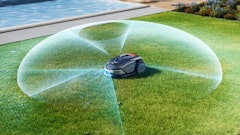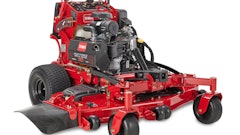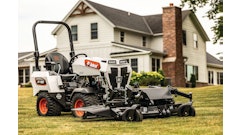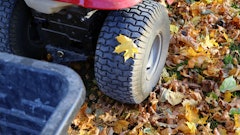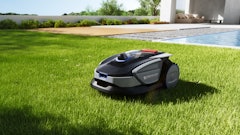
In addition to preventing accidents, robust braking and stability systems also protect the mower itself. Autonomous units are expensive investments; a runaway down a hill could mean significant damage. Thus, manufacturers treat brakes as critical components to protect both people and assets. High-torque spring-applied brakes are designed to hold loads securely and provide rapid response, even if power is cut or voltages fluctuate. They are, in effect, the last line of defense that kicks in if the software, sensors, or drivetrain encounter any fault.
Major outdoor power equipment OEMs have been quick to integrate these brake and clutch technologies as they develop autonomous models.
Each has its own approach, but all recognize that without reliable safety mechanisms, true automation is a non-starter:
- Wright Manufacturing – Autonomous Stander ZK: Wright partnered with startup Greenzie to add autonomous navigation to its popular Stander ZK stand-on mower. The autonomous ZK retains the heavy-duty Ogura clutch-brake that engages the blades on command and stops them fast when needed. Wright openly states it picks clutches that “stop fastest” after extensive dyno testing, knowing that emergency blade stop performance is vital. The Stander’s hydro drive system, when in robot mode, is managed by software, but the machine still has the same parking brakes and interlocks as the manual version to ensure it can’t roll away when inactive. This combination of proven hardware with new autonomy tech (Greenzie’s navigation kit) exemplifies how OEMs are layering automation on top of a foundation of functional safety.
- Toro / Exmark: Industry giant Toro has invested heavily in autonomous technology, acquiring robotics firm Left Hand Robotics in 2021 to accelerate development. One outcome is the Toro “Turf Pro” autonomous mower – an all-electric, self-charging mower that navigates via GPS without boundary wires . Even as Toro touts advanced wireless mapping and sensors (the Turf Pro uses GPS-RTK with ~1 inch precision, plus radar and cameras for obstacle detection), it also relies on time-tested safety components: electromagnetic blade clutches and motor brakes. Toro’s autonomous units have multiple redundancies – for example, an array of six cameras, LiDAR, and radar on the Left Hand Robotics RT-1000 mower allow it to detect people and obstacles in its path. Once an obstacle is detected, however, it’s the brakes and clutches that must physically enforce the stop. Toro ensures their designs meet ANSI safety stops, and they incorporate features like remote e-stop buttons and automatic blade stoppage. Likewise, Exmark (a Toro-owned brand) has explored prototypes of robotic mowers for turf care – you can bet they will leverage the same electric PTO clutches found in their traditional commercial mowers, given those units’ decades-long record of reliability in blade control.
In an era where qualified landscaping labor is hard to find, that efficiency gain is a game-changer.
- RC Mowers: A relative newcomer, RC Mowers focuses on remote-operated robotic mowers for extreme slopes and difficult terrain. Their tracked mowers (like the TK-52) are essentially unmanned slope brush cutters. Safety is a major selling point – RC’s literature highlights that their mowers allow an operator to be safely situated away from dangerous areas, rather than riding the machine on a 50-degree dam incline. To enable this, RC Mowers uses features such as dual-roll bar protection for the machine, operator presence sensors on the remote, and reliable braking systems. The hydrostatic drives on these units lock hydraulically and/or mechanically when the remote control is not commanding motion. The blades are engaged via an electric clutch only when an operator intentionally activates them from the remote, and an interlock ensures the blades shut off if the remote signal is lost. In essence, RC Mowers has taken the standard zero-turn mower drivetrain and outfitted it with remote controls and fail-safes – demonstrating how core brake and clutch technology supports even cutting-edge applications. The result is a machine that can clear brush on a hazardous slope while the human controller stands a safe distance away, with confidence that if anything goes awry, the mower will stop itself.
- Spider: The Czech-designed Spider slope mowers (now sold globally) pioneered remote-controlled mowing on extreme slopes. With a low-profile, four-wheel-drive design and a 360-degree turning capability, they are built to prevent tipping. Spider equipped their mowers with an array of unique safety features: not only will an emergency stop button kill the engine and stop the blades in under 5 seconds (exceeding industry blade-stop requirements), but as noted earlier, the wheel motors lock solid on power loss to hold the mower in place. These mowers even include tilt sensors – if a Spider somehow did start to tip, it can automatically shut off to mitigate damage. The company emphasizes that remote mowing keeps users off the slope entirely, removing the risk of rollover injuries to the operator. By combining a low center of gravity machine architecture with swift blade/brake systems, Spider units exemplify a holistic approach to autonomous mower safety. They even added a hydraulic stabilizing winch on some models for the most extreme hills, as a backup. That winch, importantly, is also fail-safe – it holds the mower if tension drops. In Spider’s design philosophy, every possible failure mode is addressed by a mechanical or hydraulic safety catch (brakes, locked wheels, tethers) so that even if the electronics fail, the mower won’t become a runaway hazard.
- Husqvarna: No discussion of autonomous mowing is complete without Husqvarna, whose Automower robotic mowers have logged decades of service in backyards. While Husqvarna’s offerings have mostly been smaller-scale (battery-powered units for lawns), they have influenced safety expectations industry-wide. Automowers use lift and tilt sensors to instantly shut off blades if the unit is picked up or tips over. They also incorporate rubber bumpers and ultrasound sensors to detect contacts and stop. Husqvarna’s new large-scale autonomous mower, CEORA, which targets commercial turf up to 18 acres, continues this safety-centric design with virtual boundary technology (EPOS) and multiple safety sensors. CEORA’s blades are small and tucked under the mower deck, but like bigger mowers it still relies on electronic clutching and braking – its software-controlled motors stop almost immediately when an obstacle is detected, and it uses software geofences to avoid going where it shouldn’t. Husqvarna has been a leader in proving that autonomous mowing can be done safely at scale, influencing standards and best practices. Many of those best practices, such as rapid blade stop, obstacle sensing, and automatic shutdown on fault, have been adopted by the newer entrants in larger autonomous mowers.
What these examples show is a clear duality. OEMs are marrying advanced automation tech (GPS mapping, vision, AI route planning) with rock-solid mechanical safety systems (brakes, clutches, and interlocks). The sensors and software serve as the eyes and brain, but the brakes and clutches are the muscles that actually carry out the critical safety actions. A mower that can drive itself is innovative — but a mower that can stop itself reliably is revolutionary and responsible.
More about robotic mowers on GreenIndustryPros.comPros and Cons of Robotic Mowers - What should you be expecting from robotic mowers? Rise of Robotics - Robotic mower manufacturers provide a look at how the robotic mowing industry can grow the green industry. The Future of AI and Outdoor Maintenance Technology - An expert in autonomous mowing discusses why robotic mowing can improve efficiencies, reduce dependency on human labor and eliminate waste. |
Dual Benefits: Safety and Efficiency Drive Adoption
Investing in autonomous mowing technology yields a powerful one-two punch for commercial landscapers and equipment operators. First, there’s the clear labor-saving benefit: these machines can run with minimal supervision, offsetting labor shortages and allowing one worker to manage multiple mowers at once.
A single autonomous mower can often cover as much ground in a day as a small crew could, keeping maintenance on schedule even when staffing is lean. This directly translates to cost savings and higher productivity. These machines have allowed businesses to redeploy employees to more detailed landscaping tasks while the robot handled routine mowing, effectively generating “thousands of dollars a season” in added revenue by completing extra work without extra hires.
In an era where qualified landscaping labor is hard to find, that efficiency gain is a game-changer. Secondly, and equally important, is the functional safety benefit.
Autonomous mowers, when designed as we’ve described, can actually reduce injuries and accidents on the jobsite. They excel at tackling jobs that are risky for humans – whether it’s clearing a steep berm, mowing along a busy highway, or cutting grass under low-hanging tree limbs where an operator might be tempted to duck unsafely.
Manufacturers are working closely with standards bodies to ensure autonomous mowers meet rigorous safety benchmarks — not just blade stopping times, but also new considerations like software reliability and cybersecurity of wireless e-stop functions.
By using robots, companies keep workers out of harm’s way. And because these machines are equipped with state-of-the-art brakes, sensors, and clutches, they respond to hazards more quickly than a human could. A robot mower doesn’t get distracted or tired — if a dog runs in front of it, it will stop in milliseconds, every time. For employers, this means fewer worker compensation claims and less liability, which is a significant motivator.
The technology is evolving hand-in-hand with safety regulations, too. Manufacturers are working closely with standards bodies to ensure autonomous mowers meet rigorous safety benchmarks — not just blade stopping times, but also new considerations like software reliability and cybersecurity of wireless e-stop functions.
The presence of proven mechanical safety components (like spring-set brakes or blade clutches) in these designs provides a foundation of trust for regulators and users alike, since those components have a long track record in conventional equipment. From a design perspective, focusing on brakes and clutches has not limited innovation – in fact, it’s enabling it.
Engineers can design mowers with drive-by-wire systems and fly-by-wire controls precisely because they know an independent braking system can always override motion if something goes amiss. This redundancy is what allows, say, a 1,250-lb. autonomous mower to operate unmanned near a sports field. It will cut the grass with precision GPS guidance, but if a soccer ball or person crosses its path, the lidar/camera system triggers an immediate stop and the electromagnetic brakes physically lock it in place. Such assured safety actions give facility managers the confidence to deploy these robots widely. It’s telling that early adopters of autonomous mowers often cite safety improvements even more than labor savings.
By eliminating rollover risks and projectile hazards to operators, autonomous mowers with proper safety systems make high-risk grounds maintenance tasks far safer than before.
Toward a Safer, Smarter Mowing Future
Autonomous commercial mowers are rapidly transitioning from novel prototypes to everyday workhorses in landscaping fleets. As we’ve discussed, their success hinges not only on intelligent navigation and automation software, but equally on the safety hardware that underpins every motion. Electromagnetic clutches and spring-applied brakes — many of them perfected by suppliers — are the guardians of these robotic mowers, ensuring blades engage only when and where they should, and that both blades and vehicle come to a swift halt whenever human or system demands it.
The goal is an autonomous mower that a groundskeeper can trust implicitly.
This synergy of high-tech automation with rock-solid mechanical safety is allowing the industry to overcome labor shortages without compromising on safety. In fact, safety and productivity are proving to be complementary: a mower that can stop on a dime also happens to be one that can work independently near people, unlocking hours of labor that would otherwise require full-time supervision.
The design trends in autonomous mowers reflect this dual value. We see low-profile, stable mower architectures with low centers of gravity for hill work, paired with fail-safe braking so they hold position autonomously. We see virtual boundary and mapping technologies (RTK GPS, geofencing, wireless remote control) making deployment easier, while robust emergency stop systems (wireless e-stop remotes, obstacle sensors, redundant brakes) make operation safer. It’s a melding of the digital and mechanical worlds.
As autonomous mowers continue to evolve, the best practices established now — using reliable clutches, brakes, and safety interlocks — will set the standard for all outdoor robots to follow.
The goal is an autonomous mower that a groundskeeper can trust implicitly. On that pros can trust to get the job done (even on the toughest terrain) and do no harm in the process. Achieving that requires careful attention to every safety detail, especially the brakes and clutches that physically execute safe behavior.
The industry experts know this, which is why we’re seeing such emphasis on these components in the latest models. As one might say, you can’t have automation without safety — and thanks to innovations in electromagnetic brake and clutch technology, today’s autonomous mowers are delivering both in equal measure. The result is a smarter, safer future for keeping our green spaces trimmed and tidy, with humans overseeing the process at a comfortable (and safe) distance.
This is Part 2 of 2 on the role of brakes and clutch technology in autonomous mowers.

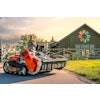


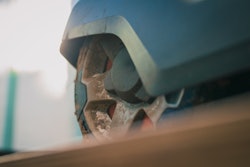
![Gravely Pro Turn Mach One My23 Dsc03139 Edit 1200x800 5b2df79[1]](https://img.greenindustrypros.com/mindful/acbm/workspaces/default/uploads/2025/10/gravely-pro-turn-mach-one-my23-dsc03139-edit-1200x800-5b2df791.BucBnDoN22.jpg?auto=format%2Ccompress&fit=crop&h=167&q=70&w=250)


![Gravely Pro Turn Mach One My23 Dsc03139 Edit 1200x800 5b2df79[1]](https://img.greenindustrypros.com/mindful/acbm/workspaces/default/uploads/2025/10/gravely-pro-turn-mach-one-my23-dsc03139-edit-1200x800-5b2df791.BucBnDoN22.jpg?ar=16%3A9&auto=format%2Ccompress&fit=crop&h=135&q=70&w=240)


